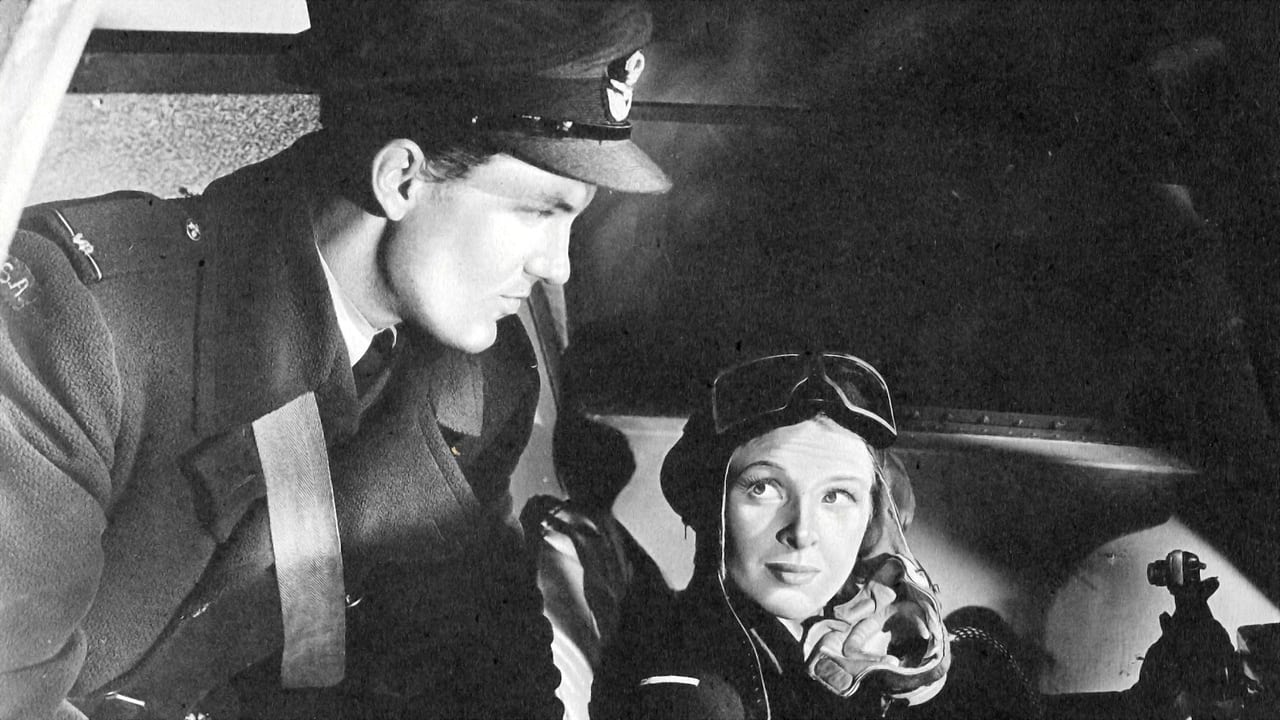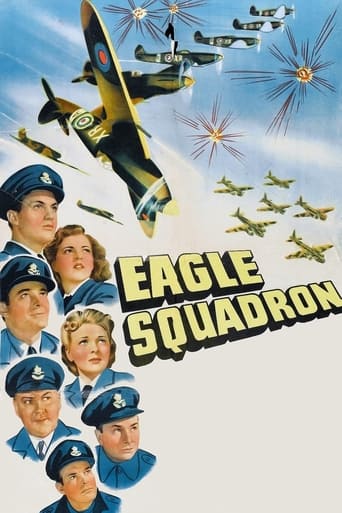Mabel Munoz
Just intense enough to provide a much-needed diversion, just lightweight enough to make you forget about it soon after it’s over. It’s not exactly “good,” per se, but it does what it sets out to do in terms of putting us on edge, which makes it … successful?
gordonl56
EAGLE SQUADRON – 1942This Universal Pictures wartime flag waver was released just 6 months after the United States entry into the war. It is the story of a group of American pilots who have joined the RAF to fight against the NAZI menace. The pilots include, Robert Stack, Jon Hall, Alan Hale Jr, Edgar Barrier, Eddie Albert and Leif Erickson. Also in the cast is, Stanley Ridges, Nigel Bruce and John Loder with the distaff side represented by, Isobel Elsom, Evelyn Ankers and a 21 year old, Diana Barrymore.The film starts with Stack, Erickson and company arriving at a RAF base. They have been assigned to one of the EAGLE squadrons of the RAF. These were squadrons with mostly American personal. Of course the soon to a standard war film cliché pops up. You have the pilots from the big city, the country boy, the new American citizen whose ex-homeland is now under the thumb of the Nazi's and so on.Stack of course falls for one of the pretty girls from the air operations shack, Diana Barrymore. Stack is a rather naive sort who thinks the whole war deal is just a lark. That changes when three of the squadron, including his pal, Leif Erickson are shot down and killed on Stack's first mission. Stack takes this very hard and cannot understand the unit's veteran pilot's apparent lack of reaction to their fellow squadron mate's deaths. It does not occur to, Stack, that any of them could be next for the chopper. They say it is best to have a few drinks and laughs than worry about it. It takes a bit of Miss Barrymore's ample charms to get Stack to behave like an adult. She shows him around a bombed out London and such. They take a group of war orphans out for a picnic. Of course the evil Germans decide to launch an air raid and strafe the party of children. Now Stack is suitably annoyed with the Nazi bunch. The Germans are having a field day knocking down Spitfires with their new fighter, the Leopard. British intelligence has learned that the Germans have a device installed in this new fighter that allows them to see through fog and cloud cover. This lets them hide in the clouds and ambush the British sorties over France. The Brits arrange a late night Commando raid on a German airfield close to the coast. They take Stack and his commanding officer, John Loder along on the raid. The plan is for the pilots to steal several of the new Leopard fighters, then, fly them back to England. Needless to say, the plan goes sideways and the surviving Commandos are called back to re-board their landing craft. This recall order does not reach all of the raiding party. Stack, Loder and several Commandos are caught in a hail of German bullets, killing the Commandos and badly wounding Loder. Loder orders Stack to continue with the mission. He will fire on the German in order to draw their attention. Stack uses the cover to grab one of the Nazi aircraft and take off. The Germans are not amused and send three more Leopard fighters in pursuit. Stack radios the British he is coming in hot, with three mad as hornets Germans chasing him. The RAF launches a squadron of Spitfires to escort Stack to base. The problem here though, is it will take 10 minutes before aid will arrive. Stack now shows his superior dogfighting ability and downs the three pursuers. The Spitfire escort joins him and all return to base. Also in the cast in unbilled parts are, Alan Napier, Audrey Long, Peter Lawford and, Peggy Ann Garner, The director was Arthur Lubin. Lubin was a long time B-unit man best known for several Abbott and Costello, and Francis the talking Mule films. Diana Barrymore was the daughter of screen legend, John Barrymore. She had that Barrymore chin. She also had the family fondness for the bottle and by 1945 had drunk herself off screen. She would die of suicide at age 38. There are times in this film where Diana is the spitting image of current actress, Drew Barrymore. Drew is the daughter of Diana's brother, John Drew Barrymore. Before her death in 1960, she published a tell all bio, TOO MUCH, TOO SOON. This was turned into a film with Dorothy Malone playing Diana and Errol Flynn as her father, John. Also of note here is the writer of the story, C.S. Forester. Forester wrote the novels, stories or screenplays for, BROWN ON RESOLUTION, COMMANDO STRIKE AT DAWN, CAPTAIN HORATIO HORNBLOWER RN, SINK THE BISMARK, THE PRIDE AND THE PASSION, SAILOR OF THE KING and THE African QUEEN. This is a rather hard to find film that seems to have slipped through the cracks somehow.
doslobos
Robert Stack makes a pretty good typically brash young American who joins the Eagle Squadron (a unit of American fliers within the British RAF) for all the typically wrong reasons. He meets a beautiful WAAF officer played by Diana Barrymore, who has a different, more adult view of the war against Nazi Germany. At the time of the film it was basically an air war. Britain was being heavily bombed and the Eagle Squadron fliers (and of course the rest of the RAF) were fighting back.The motion picture is typically campy — mostly deliberate "high" camp. Stack's character would probably have called some of it "corny." But it is an important picture for the same reason that many of World War II films, many of them not much above the B movie level — many in it — are because it can teach the viewer something about the people who watched the film(s) at or near the times of issue. A very large percentage of the population of this country watched motion pictures of this type and most realized that some at least were pretty campy and most, if they involved Americans in important roles, reflected a somewhat higher standard than most of us, who although professing it, could attain.Many in the 1940s believed that World War II was a fight — the fight — for freedom; a fight, in the language the day, to make the world safe for democracy. Surprisingly, when viewed from this distance, many people believed that and some in fact still do. Our hero — a very young Robert Stack — eventually figures all all out. No comment here on just how he does it.

